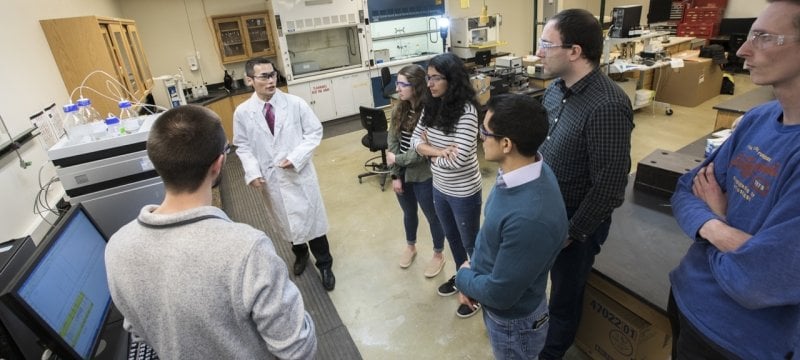A new computational tool developed at Michigan Technological University assists in the urgent quest to eliminate the persistent chemicals known as PFAS from community water supplies.
Because of their unique properties, per- and polyfluoroalkyl substances (PFAS) are used everywhere in daily life — from water-repellent clothing and nonstick cookware to pizza boxes, ski wax, fast food wrappers and firefighting foam.
“PFAS contain a very strong carbon-fluorine bond, not easily degraded by biological activities,” said Daisuke Minakata, an associate professor of civil, environmental and geospatial engineering. “PFAS can remain in the environment almost forever; thus, they are called ‘the forever chemicals.’ They end up contaminating our groundwater and surface water, our waterways, and eventually our drinking water and ecological systems, too — including freshwater fish.”
About the Researcher
Chemical industries manufacture PFAS with different properties for specific commercial products; there are approximately 4,000-5,000 known types. While toxicological impacts are still largely unknown, PFAS are potentially carcinogenic, Minakata said. Small concentrations of PFAS have been found in human bloodstreams. As a result, the state of Michigan and the U.S. Environmental Protection Agency (EPA) recently began regulating the levels of several types of PFAS under the Safe Water Drinking Act.
Responding to PFAS detected in water is challenging for communities in Michigan and elsewhere. “Some water authorities have already located the source of PFAS contamination in their drinking water,” Minakata said. “It’s a start. However, because of the budget constraints faced by many local governments, they simply cannot afford to employ advanced water treatment technologies to remove the PFAS.”
"Our new computational tools provide helpful guidance and methods to researchers around the world who seek to forever destroy these forever chemicals."
Cost is not the only barrier. “Local water authorities are struggling to implement available technologies to remove PFAS from water sources,” Minakata said. “Current technologies — such as adsorption of granular activated carbon and ion exchange — offer only a phase transfer of PFAS from water to carbon media, which then require regeneration and replacement.” Another concern: “Carbon-based adsorption works for longer chain PFAS, but those are now being phased out of the market,” he said. “They are being replaced by smaller chain PFAS. The smaller chain PFAS do have fewer toxicological concerns, but they are not well removed by adsorption.”
And, there’s another problem. “Most currently available remediation technologies do not actually destroy PFAS,” Minakata said. “Instead, these technologies transfer PFAS from one phase to another. They are conveniently implemented in order to meet the new EPA regulations. But it’s going to backfire. Unless we fully destroy the structure of PFAS, we’re bound to encounter larger, more fundamental problems.”
Minakata believes PFAS will end up in wastewater and landfill leachate as a result of current PFAS remediation technologies, albeit in very low concentrations. “PFAS will then be transported back to the environment through evaporation, atmospheric deposition and biosolids. The recycled biosolids may then be used in agriculture, so PFAS could eventually contaminate food crops,” he said.
A New Computational Tool for Advanced Reduction
Even so, Minakata sees a light at the end of the PFAS tunnel. His research group recently published a paper outlining a new PFAS computational tool, “Reactivities of hydrated electrons with organic compounds in aqueous-phase advanced reduction processes” in the Royal Society of Chemistry journal Environmental Science: Water Research & Technology.
Minakata and Michigan Tech graduate student Rose Daily, a National Science Foundation graduate research fellow in environmental engineering, used data science and computational chemistry to study hundreds of structurally diverse organic chemicals to predict PFAS reactivities.
“Our methods can be expanded and used to screen thousands of PFAS,” says Minakata. “The key is understanding the reactivities of solvated electrons with organic chemicals and PFAS. With that knowledge, you can screen a great number of PFAS contaminants and prioritize them for the application of advanced reduction processes to degrade — and hopefully fully destroy — PFAS.”
Minakata’s research findings can also be used to strengthen and improve current PFAS remediation applications, including electrochemical oxidation techniques.
Fundamental Research: Reactivities of Electrons
“I have studied the oxidation of organic contaminants in water and wastewater for 20 years,” Minakata said. “Each PFAS is very unique and many are oxidized forms; thus, oxidation does not destroy PFAS well.” Researchers worldwide are now looking to reduction technologies that rely on electrons, he said.
“Electrochemical reduction using electrons is one technology with promising results. Researchers are now working on the electrode materials and reactor design to improve efficiencies for real-world application. It is here that my fundamental research can provide valuable information about reactivities of electrons that, up until now, have not been well understood.”
Suggested Focus: Target the Largest Concentrations of PFAS
Get the PFAS where it’s most prevalent, says Minakata. “Rather than targeting extremely low concentrations of PFAS in water, research and remediation should identify and target the points where PFAS concentrations are relatively high,” he said. “That would be a much better way to affordably, effectively and efficiently destroy PFAS.”
Next, Minakata and his collaborators plan to study the physical distribution of PFAS. “We want to go about finding PFAS hotspots — places where we can apply these promising technologies — in order to destroy large amounts of PFAS at one time.”
PFAS presents environmental justice issues, noted Minakata, whose research in this field is partially supported by Central Chemicals. “Rather than covering up PFAS problems, like putting small bandaids on serious injuries, we environmental engineers must tackle and solve the fundamental problem of PFAS in collaboration with scientists, industries, communities and policymakers,” he stated.
Michigan Technological University is an R1 public research university founded in 1885 in Houghton, and is home to nearly 7,500 students from more than 60 countries around the world. Consistently ranked among the best universities in the country for return on investment, Michigan's flagship technological university offers more than 120 undergraduate and graduate degree programs in science and technology, engineering, computing, forestry, business, health professions, humanities, mathematics, social sciences, and the arts. The rural campus is situated just miles from Lake Superior in Michigan's Upper Peninsula, offering year-round opportunities for outdoor adventure.







Comments